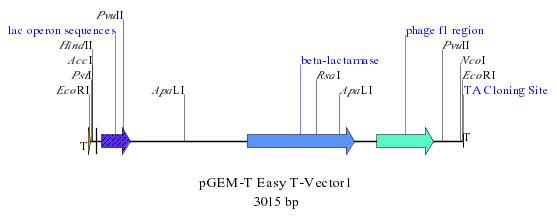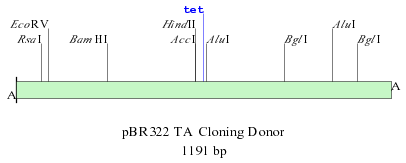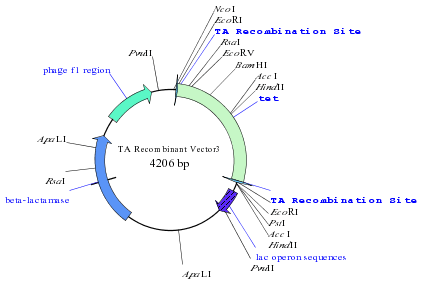References >> TA Cloning
TA Cloning TechnologyIntroduction to TA Cloning
TA Cloning is one of the most popular methods of cloning the amplified PCR product using Taq and other polymerases. These polymerases lack 5'-3' proofreading activity and are capable of adding adenosine triphosphate residue to the 3' ends of the double stranded PCR product. Such PCR amplified product can be cloned in a linearized vector with complementary 3' T overhangs.
TA Cloning Functioning
TA cloning is brought about by the terminal
transferase activity of certain type
of DNA polymerase such as the Taq polymerase.
This enzyme adds a single, 3'-A overhang
to each end of the PCR product. As a
result, the PCR product can be directly
cloned into a linearized cloning vector
that have single base 3'-T overhangs
on each end. Such vectors are called
T- vectors. The PCR product with A overhang,
is mixed with this vector in high proportion.
The complementary overhangs of a "T"
vector and the PCR product hybridize.
The result is a recombinant DNA, the
recombination being brought about by
DNA ligase.


In Sillico TA cloning with SimVector
SimVector makes it so easy to design TA cloning experiments. The TA cloning wizard accepts both commercial T-vectors or a restriction designed T-vector to combine them with the modified PCR product and generates a highly accurate recombinant DNA plasmid map.
Other techniques performed by SimVector:
Gateway® Cloning
Using SimVector you can perform both BP and LR reactions of Gateway® Cloning. A donor and an expression vector are required for the BP reaction and for generating an entry clone. An entry and a destination vector are required for the LR reaction and for generating an expression vector.
Restriction Cloning
This cloning technique requires restriction enzymes to cut the vector molecule and the molecule to be cloned. SimVector performs restriction enzyme analysis and allows you to filter, annotate and map the restriction enzymes on the desired sequences.
Restriction Enzyme Analysis
SimVector identifies restriction enzyme recognition sites in DNA sequences for restriction site mapping. A comprehensive database of over 1000 restriction enzymes is used for the restriction analysis. Two modes of enzyme filtering are provided to specify the parameters for restriction analysis. Enzyme filtering enables you to set the enzyme criteria to match your experimental requirements. For convenience, enzyme sets from more than 20 commercial providers are included.
Draw Accurate Plasmid Maps
SimVector is an exceptional tool to draw publication quality plasmid maps. The graphics can then be enhanced with patterns, styles, lines, and colors. SimVector generates plasmid map images in vector graphic format for Adobe Illustrator 10 and Microsoft PowerPoint 2002.


